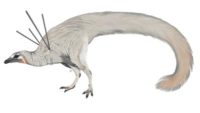What does the ear’s design show about the Creator? …read more Source: creation.com
All plant and animal genomes studied so far exhibit complex and distinct three-dimensional (3-D) structures in their chromosome configurations depending on the type of cell (e.g., heart, liver, brain, etc.). Given the incredible variability among genome configurations within a single type of creature, let alone that which exists between creatures (e.g., human vs. chimpanzee), this area of evolutionary comparison has been difficult for secular res… More… …read more Source: icr.org
How should we explain one of the deepest Cenozoic sedimentary basins in biblical framework? …read more Source: creation.com
By Dr. Danny R. Faulkner Hopefully, 2021 will see the demise of COVID-19 and the many restrictions prompted by concerns about its spread, and so perhaps we soon can get back to normal. …read more Source: AIG Daily
Creationists have long speculated about the earth’s environment prior to the global Flood—conditions which may have contributed to the long human life spans recorded in the Biblical record of Genesis. Specifically, it has been hypothesized by some that the pre-Flood earth atmosphere had higher levels of oxygen and a greater atmospheric pressure than we currently observe. Now, a new study from Tel Aviv University and the Shamir Medical… More… …read more Source: icr.org
Is The Flintstones a more accurate picture of Neandertals than evolutionary documentaries? …read more Source: creation.com
By Dr. Alan L. Gillen Shortly after Darwin published On the Origin of Species, Pasteur began to challenge the idea of spontaneous generation. …read more Source: AIG Daily
By Dr. Andrew A. Snelling How could a series of sedimentary layers fold without fracturing? The only way is for all the sedimentary layers to be laid down in rapid succession and then be folded while still soft and pliable. …read more Source: AIG Daily
Does pregnant ‘Mary’, a stickleback fish from the Outer Hebrides, support evolution? …read more Source: creation.com
By Ken Ham To say a new “dinosaur” being described by news media as “unusual” would be an understatement! This new “dinosaur,” Ubirajara jubatus, is described as having “a long mane of fur [really, structures that might have been feathers] down its back and stiff [nearly 6-inch] rod-like structures projecting from its shoulders.” It’s “totally weird,” one researcher says. So what is it really? Well, our paleontologist Dr. Gabriela Haynes read the original scientific paper, and here’s what she had to say about this crazy-sounding creature: It is important to understand the way that evolutionist researchers name and group animals [More]
A team from the Massachusetts Institute of Technology (MIT) used NASA’s Transiting Exoplanet Survey Satellite (TESS) to discover a gas giant in another solar system. The planet holds a new record for being a hot Jupiter-like exoplanet with the shortest year.1 Designated TOI-2109b, the planet takes just 16 hours to orbit its host star, as opposed to the earlier record-holder, which orbited its host star in 18 hours… More… …read more Source: icr.org
Two separate spider research projects published remarkable results, both in the journal Current Biology. These spiders’ specific features show their miniature skills, and cause us to marvel at their Maker. Andrew Gordus is a neurobiologist and was the senior author of a recent spider web study. He told Johns Hopkins University, “After seeing a spectacular web, I thought, ‘if you went to a zoo and saw a chim… More… …read more Source: icr.org
By Lisa Smetak God designed some amazing glow-in-the-dark creatures that make their own light. …read more Source: AIG Daily
Rock layers in China have yielded yet another strange bird. Two features in its partial skull—the only parts found—make it both a unique discovery and a challenge to nature-only origins stories. First, its beak is long and curved like a modern hornbill. That’s a first among the many birds trapped in Cretaceous rock layers alongside fishes, dinosaurs, and crocodilians. The research team published details of the fin… More… …read more Source: icr.org
By Dr. Jason Lisle Phil Vischer apparently does not accept the history recorded in Genesis, and seems unaware of the science that confirms creation and the biblical timescale. …read more Source: AIG Daily
Dr Robert Carter answers questions about the why so many scientists think humans evolved in Africa and if God created predators. …read more Source: creation.com
Not only can plants ‘hear’, but they can respond rapidly. …read more Source: creation.com
By Dr. Danny R. Faulkner An explanation of the December solstice, an overview of its celebration in pagan cultures, and a potential Christmas Star on December 21. …read more Source: AIG Daily
Scientists have identified a large slab of cold oceanic lithosphere1 dipping far beneath China.2 The newly imaged plate is presumably a leftover piece of ocean that was consumed as the Indian subcontinent collided with Asia, forming the Himalayan Mountains. However, its high seismic velocity and apparent cold temperature indicate fast emplacement befitting runaway subduction, catastrophic plate tectonics, and a recent global… More… …read more Source: icr.org
How to link the evidence to Noah’s Flood …read more Source: creation.com
By Heather Brinson Bruce The snow leopard survives in its frigid climate thanks to a collection of cool features. …read more Source: AIG Daily
Sever an arm from an octopus, and like an underwater zombie it’ll keep groping its surroundings. Even without a brain, its suckers still detect and grab crabs in lab experiments. Now Harvard researchers have begun discovering what makes octopus suckers so smart. The team led by molecular biologist Nicholas Bellono found special sensory cells on each sucker’s skin surface.1 One type of sensor houses mechanorec… More… …read more Source: icr.org
God’s creative power on display …read more Source: creation.com
Dogs don’t read the words on a page. Neither did Coco, the famous gorilla that learned to communicate using simple hand signs. So what affords humans the unique ability to read and write, and why do we do it? These kinds of questions drive Zeynep Saygin’s research at Ohio State. Her team’s recent discovery sets the stage for some answers. Brain experts already knew about the visual cortex—an area of the brai… More… …read more Source: icr.org
How do chemicals “decide” to become alive? That they can, and did, is essentially the basis for today’s widely accepted origin-of-life theory. But Rice University professor James Tour, a synthetic organic chemist who is widely considered one of America’s leading experts in nanotechnology and nanoengineering, says this theory is not only unproven but untenable. Moreover, he states that in private, many fellow scientists agree with him. Read More: Scientists Are “CLUELESS” About Origins of Life, Says Top Chemist and Nanotechnologist – The New American
By Ken Ham In a new study, scientists compared the visual system of a very tiny lemur from Madagascar, the mouse lemur, with that of other primates and found that “the size of these visual processing units is identical in all primates, independent of their body size” and that “the way the units are arranged across the brain was totally indistinguishable, following the same rules with mathematical precision . . . [and] the number of nerve cells per visual unit was almost identical.” Now why is this significant? Well, this is considered important in the evolutionary view because mouse lemurs [More]
Despite the latest failure to detect dark matter, why do they continue searching? …read more Source: creation.com













































